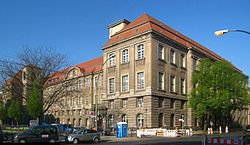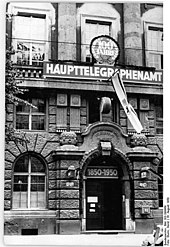Main Telegraph Office Berlin
| Main Telegraph Office | |
|---|---|
 View from the corner of Monbijoustraße and Oranienburger Straße |
|
| Data | |
| place | Berlin-Mitte , Oranienburger Strasse |
| architect |
Wilhelm Walter , Max Lehmann |
| Architectural style | Neo-baroque |
| Construction year | 1910-1916 |
| Coordinates | 52 ° 31 '27.5 " N , 13 ° 23' 40.5" E |
The former main telegraph office in the Oranienburgerstraße 73-76 in Berlin district center of the district of the same is a listed monument. From its opening in 1916 to 1992, it served as the headquarters of the telegraph facilities in Berlin. The monumental building complex has been owned by an investor since 2001. After renovation and renovation work, the interior will be used as an office and commercial building.
location
The four-wing building complex extends along Oranienburger Straße 73-76 (north), Monbijoustraße 1 (east), Ziegelstraße 20/21 (south). The logenhaus adjoins it to the northeast in Oranienburger Strasse, while the former telephone exchange limits the area to the east in Tucholskystrasse.
history
With the reorganization of the postal administration, the General Telegraph Directorate in the Französische Strasse 33 (HTA) was formed in October 1875 with Department II in the Reich Chancellery. From 1877–1878, according to plans by Carl Schwatlo , the Jägerstrasse 44 / Französische Strasse 33 building complex was the first main telegraph office in Berlin.
The Oberpostdirektion (OPD) Berlin of the Reichspost needed a central building for the modern and emerging telephone technology in the following years for the rapidly growing capital of the German Empire. Post construction officer Wilhelm Walter and the architect Max Lehmann produced a design, which was carried out by the site manager Hermann Streubel from the OPD Berlin . For 3.1 million marks (adjusted for purchasing power in today's currency: around 7.51 million euros), the most complex and expensive post office building in Germany was built between 1910 and 1916. It was equipped with the latest telegraph technology and in the first few years also served as a development center for German radio communications . For example, the employees were able to control the military radio station set up in Königs Wusterhausen in 1916 , as well as the major radio station in Nauen . Only in 1918, after the end of the First World War , did the telegraph office fully begin its work. The telegraph technology was housed on each floor of the east wing, separated according to different target areas.
In the basement and on the ground floor, the city tube post center was put into operation in 1919 .
The pneumatic tube post was shut down in East Berlin in 1977 , its connections and control devices dismantled in 1986 and stored in the basement, some parts also ended up as exhibits in the Museum for Communication . The machine center in the basement of the HTA was retained and could be viewed by interested visitors until 2008. Together with the control devices, it is considered a technical monument worth preserving. After multiple agreements between all parties involved, part of the machine station in the new hotel area is to be rebuilt and presented to the public.
After German reunification, the entire building complex became the property of Telekom and after the establishment of subsidiaries it came to DeTeImmobilien . All parts of the telegraph office were shut down in 1992. DeTeImmobilien managed to find a buyer in 2001 with the investor Freiberger Holding . According to his plans, the ensemble will be renovated as part of the Forum Museum Island project and converted and expanded for offices, shops and restaurants. The side wing on Monbijoustraße is intended as a hotel. According to initial announcements, the work should be completed in 2014 and cost around 300 million euros. The construction work actually took longer, but the first facilities were ready for use in 2016.
architecture
The building complex in the neo-baroque style has been adapted to the existing street network, so the four building wings are not positioned exactly at right angles to each other. The north wing on Oranienburger Straße is about 65 meters long, the south wing on Ziegelstraße is about the same length. The east wing on Monbijoustraße jumps back around 13 meters compared to the two aforementioned parts of the building and is around 30 meters long. The interior west wing, which is parallel to it, is around 33 meters long. A central building connects these two wings. The inner courtyards created in this way , each 20 meters wide and around 30 meters long, were originally provided with a glass roof that was not rebuilt after the Second World War. On both courtyards there is a stair tower with a semicircular floor plan attached to the facade.
The building complex is four floors high throughout, has lofts with dormers in some places and is closed off by a tiled mansard roof. Trachyte served as the building material for the base .
The facades have been plastered gray , the basement and the two stair towers in Monbijoustraße with a rectangular floor plan are structured by means of bosses , their window niches and entrances form round arches . A symmetrical arched gable closes off three axes of the building section in Monbijoustraße.
The 14-axis main facade on Oranienburger Strasse is dominated by colossal pilasters and a row of four three-quarter columns positioned axially above the ground-level portal. Above its two-winged bronze door is a segmented arch with the inscription “Haupttelegraphenamt” in metal letters and capital letters . A cartouche above the symbolic keystone of the archway contains the slightly ornate inscription in an ornamented oval: "Telegram acceptance".
The high halls inside the building housed the equipment for the telegraph service as well as telegram acceptance, a public telephone, a pneumatic post office, packing rooms for the parcel post office and the central post and telecommunications office .
literature
- Main telegraph office on Oranienburger Strasse in Berlin. In: Berliner Architekturwelt. 18: 337-340 (1916).
- Seventy-five years of the Berlin Main Telegraph Office., At the same time a contribution to the history of telegraphy. Ernst Litfass' heirs, Berlin 1925.
Web links
- Main Telegraph Office Monument
- List of listed buildings of the postal and telecommunications system
- The construction site around the former main telegraph office in an aerial video from September 2018. At: aerialvideossearch.com
Individual evidence
- ↑ Main Telegraph Office Monument
- ↑ a b c Main Telegraph Office in Oranienburger Strasse in the German Digital Library , accessed on April 12, 2015.
- ↑ a b c d e On the architecture and history of the HTA at forum-museumsinsel.de ( Memento from January 30, 2015 in the Internet Archive ), accessed on April 12, 2015.
- ^ The old telegraph office facing an uncertain future , In: Berliner Kurier , accessed on December 15, 2017.
- ↑ Information about future use on architektur-bildarchiv.de , accessed on April 12, 2015.
- ↑ Isabell Jürgens: This is where Berlin's largest private building project is taking place. Berliner Morgenpost , September 8, 2011, accessed on September 18, 2019 .
- ↑ Alfons Frese: Moving into Berlin's most exclusive property. Der Tagesspiegel , August 6, 2016, accessed on September 18, 2019 .
- ↑ Institute for Monument Preservation (Ed.): The architectural and art monuments of the GDR. Capital Berlin-I . Henschelverlag, Berlin 1984, p. 284 .
- ↑ main telegraph office on Luise.de

